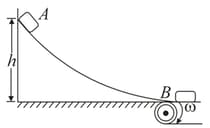Kinematics of Circular Motion
Kinematics of Circular Motion: Overview
This topic covers concepts, such as, Kinematics of Circular Motion, Circular Motion with Increasing Speed, Circular Motion with Decreasing Speed & Circular Motion with Variable Angular Acceleration etc.
Important Questions on Kinematics of Circular Motion
A smooth semicircular wire track of radius is fixed in a vertical plane. One end of a massless spring of natural length is attached to the lowest point of the wire track. A small ring of mass which can slide on the track is attached to the other end of the spring. The ring is held stationary at point such that the spring makes an angle of with the vertical. The spring constant . Consider the instant when the ring is released. The normal reaction on the ring by the track is
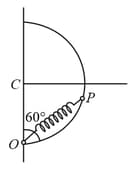
A wheel moving with initial angular velocity , stops after revolutions. The time taken by the wheel to stop is
The tangential velocity of a body in a non-uniform circular motion varies as with the radius being equal to . What is the angular acceleration at in ?
The velocity and acceleration vectors of a particle undergoing circular motion are and , respectively, at an instant of time. The radius of the circle is,
If a body moving in a circular path maintains constant speed of , then which of the following correctly describes the relation between acceleration and radius?
Starting form rest, a particle rotates in a circle of radius m with an angular acceleration α = π/4 rad/s2. The magnitude of average velocity of the particle over the time it rotates quarter circle is
The angular velocity of the minute hand of a clock is :
To enable a particle to describe circular motion the angle between its velocity and acceleration is given by
Which one is the correct relation between the magnitude of linear acceleration and angular acceleration in circular motion of radius of circular path.
Assume is linear acceleration and is angular acceleration.
An object is at the top of a smooth sphere which is kept fixed. As object slides down after being given a negligible side push, magnitude of acceleration of object during its motion till it reaches ground.
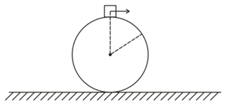
A particle moves in x-y plane according to rule x = asinωt and y = acosωt. The particle follows:
Consider a particle of mass moving in a circular path with uniform angular velocity. Which of the following is constant during it's motion?
Select the incorrect option.
If a ceiling fan is switched off,its angular velocity falls to half after it makes 36 rotations.Then Find the number of rotations it will make before coming to rest?
A rod is moving on a fixed circle of radius with constant velocity , as shown in the figure. is the point of intersection of the rod and the circle. At an instant, the rod is at a distance from the centre of the circle. The velocity of the rod is perpendicular to the rod and the rod is always parallel to the diameter .
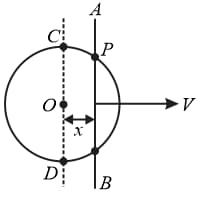
(a) Find the speed of point of intersection .
(b) Find the angular speed of point of intersection with respect to centre of the circle.
A point moves in a counter-clockwise direction on a circular path as shown in the figure. The movement of is such that it sweeps out a length where, is in metre and is in seconds. The radius of the path is . The acceleration of when is then find value of .
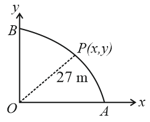
Two particles and are moving on circle. At a certain instant of time both the particles are diametrically opposite and P has tangential acceleration and centripetal acceleration whereas has only centripetal acceleration of . At that instant acceleration (in ) of with respect to is
The kinetic energy of a particle moving along a circle of radius R depends on the distance covered. It is given as , where is a constant. The force acting on the particle is
Three identical cars A, B and C are moving at the same speed on three bridges. The car A goes on a plane bridge, B on a bridge convex upwards and C goes on a bridge concave upwards. Let and be the normal forces exerted by the cars on the bridges when they are at the middle of the bridges. Then
Particles are released from rest at A and slide down the smooth surface of height h to a conveyor B. The correct angular velocity of the conveyor pulley of radius r to prevent any sliding on the belt as the particles transfer to the conveyor is
